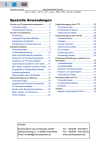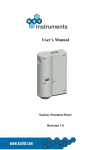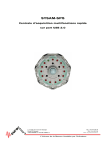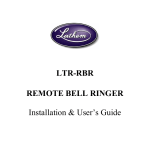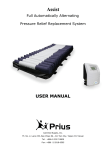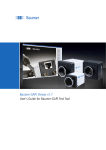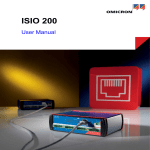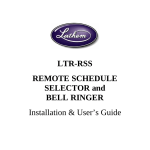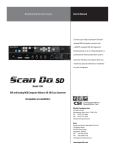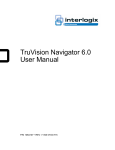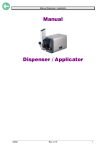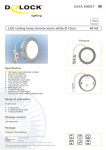Download Applicator Interface
Transcript
02/10 Rev. 5.04-02 SERVICE MANUAL ALX 92x Applicator Interface Applicator Operation ..................................... 2 Function .................................................... 2 Connecting an applicator .......................... 3 Selecting an applicator type ...................... 4 Signal-Time-Diagrams .................................. 5 Time/sensor controlled applicators ........... 5 PEP IV ....................................................... 6 PEP Blow On ............................................ 7 Reverse PEP ............................................. 8 LTP und LTPV ........................................... 9 PEP II Sensor .......................................... 10 ASA ......................................................... 11 Interface description ....................................12 Important notes ........................................12 Firmware requirements ............................12 Connector Position ..................................13 Connections and configuration ................14 Replacing older boards ............................16 Layout diagram ........................................17 Block diagram ..........................................18 Circuit diagrams for signal inputs .............19 Circuit diagrams for signal outputs ..........20 Pin assignments ..........................................22 Applicator connection ..............................22 Avery-Applicator-connection ....................24 Machine status connection ......................25 Product sensor connection ......................27 Signal LEDs .................................................28 2 02/10 Rev. 5.04-02 SERVICE MANUAL ALX 92x Applicator Interface Applicator Operation Function If direct labelling from the dispensing edge is not possible, the labeller can be equipped with an applicator. In applicator mode, the applicator takes the label from the dispensing edge and carries it to the product. The labeller can be equipped with various applicators, depending on the need. Those applicators are all driven by compressed air. The following are possible: LTP / LTPV LTP (Light Touch Pneumatic) and LTPV (Light Touch Pneumatic Vacuum): Applicator with „Light Touch“ function. „Light Touch“ means, that the movement of the (compressed air) cylinder is limited by sensors, which react to a light touch onto the product. The LTPV additionally sucks the labels on with a vacuum nozzle. Advantages: • Application on products with different heights possible • Only light pressure onto the product (important with sensitive products) PEP The cylinder movement is limited by a setable length of time. After the run out of this application time, the applicator moves back into home position. PEP Blow on PEP-type applicator with blow on function: After run out of the application time, the blow on function is activated. After run out of the blow on time, the applicator moves back into home position. PEP II Sensor The cylinder movement is limited by a (touch down) sensor, which signals the contact to the product and triggers the backwards-movement. ASA ASA (Air Stream Applicator) This applicator type has no moving parts, but blows the label onto the product (also called „blow box“). After the start signal, the blow on valve is opened for a setable time length. Reverse PEP This applicator is partly time related. Working procedure: The applicator moves to its end position and “waits“ for the start signal. The start signal triggers the blow on valve which is active for the defined blow on time. After the run out or the blown on time, the applicator moves to home position, gets the next label and moves to the wait position. BTS BTS (Bad Tag Separator) This device does the opposite of an applicator: it removes labels from the dispensing edge of a labeller. The BTS is used for sorting out RFID labels, which could not be read/written properly. 3 02/10 Rev. 5.04-02 SERVICE MANUAL ALX 92x Applicator Interface Connecting an applicator Depending on the applied applicator type, different input and output signals are used. The following applicator types, which are distributed by Avery Dennison, can be connected directly to the connector for Avery applicators, using the delivered cable, see . • LTP / LTPV • PEP IV • BTS • LA-BO (conforms to the „ASA“ type) • LA-TO (conforms to the „PEP“ or „PEP II Sens.“ type) For all other applicator types, the connection cable must be configurated by the system integrator: Inputs Outputs Home Position Touch Down Airstream Support Vacuum Cylinder Blow On +24V for fan BTS Appropriate setting for LA-TO with time control Appropriate setting for LA-TO with sensor control Appropriate setting for LA-BO With pneumatic dispensing edge Only with LTPV Legend for (Tab. 1): Input signal used Input signal not used Output signal used Output signal not used O-Ring Appl. BTS Direkt Spenden Rev. PEP ASA c) d) e) [Tab. 1] Signals which are used by the different applicator types. a) b) c) d) e) PEP II Sens. b) PEP Blow on PEP a) LTP(V) Applicator types: 4 02/10 Rev. 5.04-02 SERVICE MANUAL ALX 92x Applicator Interface Selecting an applicator type « Select the applicator type using the function APPLICATOR PARA > Applicator type. Dependent on the applicator type chosen, different functions for setting up the applicator appear in the APPLICATOR PARA menu. PEP a) PEP Blow on PEP II Sens. b) ASA c) Rev. PEP Direkt Spenden BTS O-Ring Appl. Function: LTP(V) Applicator types: Blow on time X -- X X X X X X X Restart delay X X X X X X X X X Position timeout X X X X X X X X X Start error stop X X X X X X X X X Dwell time -- X X -- -- X -- X -- [Tab. 2] Available adjustment functions, dependent on applicator type (x = function available). a) b) c) Appropriate setting for LA-TO with time control Appropriate setting for LA-TO with sensor control Appropriate setting for LA-BO 5 02/10 Rev. 5.04-02 SERVICE MANUAL ALX 92x Applicator Interface Signal-Time-Diagrams Time/sensor controlled applicators With time controlled applicators, extension is stopped after the setable application time run down. (APPLICATOR PARA > Dwell time). To this applicator group belong: • PEP IV • PEP Blow On • Reverse PEP With sensor controlled applicators, extension is stopped by the Touch Down signal. To this group belong: • LTP(V) • PEP II Sensor 6 02/10 Rev. 5.04-02 SERVICE MANUAL ALX 92x Applicator Interface PEP IV A B D C [1] Pattern of control signals over time for PEP IV applicators. A Duration is determined by label length and dispensing speed. „Airstream Support“ switching to low means the label is dispensed. B Can be adjusted via APPLICATOR PARA > Dwell time. Duration t is determined by the backwards movement of the applicator. The application cycle ends when the home position signal is high again. C The output signal „Offline“ follows the input signal „Inhibit“. D The start signal is ignored because of the active „Inhibit“. 7 02/10 Rev. 5.04-02 SERVICE MANUAL ALX 92x Applicator Interface PEP Blow On A B C D F E [2] Pattern of control signals over time for PEP Blow On applicators. A Duration is determined by label length and dispensing speed. „Airstream Support“ switching to low means the label is dispensed. B The total duration of Cylinder is the sum of both durations t1 and t2. The duration t1 is setable by APPLICATOR PARA > Dwell time; t2 is setable by “APPLICATOR PARA > Blow on time” (see note C). C Can be adjusted with APPLICATOR PARA > Blow on time. D Duration t3 is determined by the backwards movement of the applicator. The application cycle ends when the home position signal is high again. E The output signal „Offline“ follows the input signal „Inhibit“. F The start signal is ignored because of the active „Inhibit“. 8 02/10 Rev. 5.04-02 SERVICE MANUAL ALX 92x Applicator Interface Reverse PEP A B C E F D [3] Pattern of control signals over time for Reverse PEP applicators. A Duration is determined by label length and dispensing speed. „Airstream Support“ switching to low means the label is dispensed. B Adjustable with APPLICATOR PARA > Blow on time. C Duration t is determined by the backwards movement of the. applicator. The application cycle ends when the home position signal is high again D The output signal „Offline“ follows the input signal „Inhibit“. E The start signal is ignored because of the active „Inhibit“. F The end of „Cycle“ can be adjusted with APPLICATOR PARA > Dwell time (usually, this function sets the end of the „Cylinder“ signal, in case of the Reverse PEP, „Cylinder“ stays active up to the next start signal, what means that the dwell time is ignored). 9 02/10 Rev. 5.04-02 SERVICE MANUAL ALX 92x Applicator Interface LTP und LTPV Start signal Home position A Airstream support Cylinder (setable) Vacuum Touch down B t C Blow on (setable) D Offline E Cycle Inhibit [4] Pattern of control signals over time for LTP(V) applicators. A Duration is determined by label length and dispensing speed. „Airstream Support“ switching to low means the label is dispensed. B Duration t is determined by the backwards movement of the applicator. The application cycle ends when the home position signal is high again C Adjustable with APPLICATOR PARA > Blow on time. D The output signal „Offline“ follows the input signal „Inhibit“. E The start signal is ignored because of the active „Inhibit“. 10 02/10 Rev. 5.04-02 SERVICE MANUAL ALX 92x Applicator Interface PEP II Sensor Start signal Home position A Airstream support Cylinder (setable) Vacuum Touch down C B t Blow on (setable) Offline E Cycle D Inhibit [5] Pattern of control signals over time for PEP II Sensor applicators. A Duration is determined by label length and dispensing speed. „Airstream Support“ switching to low means the label is dispensed. B Duration t is determined by the backwards movement of the applicator. The application cycle ends when the home position signal is high again. C Adjustable with APPLICATOR PARA > Blow on time. D The output signal „Offline“ follows the input signal „Inhibit“. E The start signal is ignored because of the active „Inhibit“. 11 02/10 Rev. 5.04-02 SERVICE MANUAL ALX 92x Applicator Interface ASA The ASA type applicator (e.g. Avery Dennison LA-BO) is a special case, which does not have any moving parts. The label is applied only by compressed air. Therefore, signals controlling the movement of the applicator (Home Position, Cylinder) are not required. A B D C [6] Pattern of control signals over time for ASA applicators. A Duration is determined by the label length and dispensing speed. „Airstream Support“ switching to low means the label is dispensed. B Can be adjusted via APPLICATOR PARA > Blow on time. C The start signal is ignored because of the active „Inhibit“. 12 02/10 Rev. 5.04-02 SERVICE MANUAL ALX 92x Applicator Interface Interface description Important notes The Applicator Interface (AI) is an option board for the ALX 92x. The AI works as a mini-PLC, which can control almost any applicator type. The AI is available in two Versions: • AI Basic: power supply via the ALX 92x main power pack • AI Pro: higher output currents due to a separate power pack ¯ „Basic“ and „Pro“ is only mentioned in this description, if the two versions are different in something. Connectors Required connectors: The „AI connector kit“, Article no. A5069, contains (connector and connector housing for each): • 1x D-Sub 15 high density • 1x D-Sub 26 high density • 1x D-Sub 44 high density Firmware requirements Both firmware versions, for ALX 92x and Applicator Interface must match the table below: Firmware ALX 92x Firmware AI Gen. 2 Gen. 3 3.40 — 1.03 4.00 — 1.11 4.10 — 1.15 4.11/4.22 5.00/5.01/5.02/5.03 1.17 4.31 5.31 1.19 4.33 5.33 1.23 Anzeige der Firmware-Versionen: SERVICE DATA > MODULE FW VERS. 13 02/10 Rev. 5.04-02 SERVICE MANUAL ALX 92x Applicator Interface Connector Position C B D A [7] Connections of the Applicator Interface: A Applicator connection (D-Sub 44 hd) B Machine status connection (D-Sub 26 hd) C Product (Start) sensor connection (D-Sub 15 hd) D Monitor-LEDs [8] Connector for Avery Applicators (arrow) at an ALS 92x (LH). The connector is internally connected to the AI board. 14 02/10 Rev. 5.04-02 SERVICE MANUAL ALX 92x Applicator Interface Connections and configuration D a E F C G H B I J A K O [9] N M L Applicator Interface (PCA-Assy. = A4455-03) A CN 603: Connection for applicator B CN 602: Signal interface machine status C CN 401: Connection product (start) sensor D Light guides, which lead the LED signals from the plug-on board (a) to the boards mounting panel E CN 402: Internal connection product (start) sensor F CN 610: Internal signal interface machine status G CN 101: Connection CPU board H JP 101-104; JP 202: Jumpers for factory internal use 15 02/10 Rev. 5.04-02 SERVICE MANUAL ALX 92x Applicator Interface JP104 JP103 JP102 JP101 JP202 [10] Default settings for the jumpers JP 101-104 and JP 202. I CN 102: Debug interface J CN 604: Connection power supply K CN 605: not used L SI 601: Fuse – AI Basic: T1AH 250V – AI Pro: T4AH 250 V M D 331: Green LED; only for factory internal use; flashes if the AI works properly N D332: Yellow LED; only for factory internal use O CN 609: Internal connection applicator 16 02/10 Rev. 5.04-02 SERVICE MANUAL ALX 92x Applicator Interface Replacing older boards CAUTION! - Follow the following, to prevent malfunctioning: « When replacing an older board with index -00/-01/-02 against a new board with index -03 do not take over the jumpers from the old board. Older boards with index -00/-01/-02 had jumpers set on connector [11C]. New boards (index -03) provide additionally to [11C] the connectors [11A] and [11B]. ¯ None of the 3 connectors may have any jumpers put on it! A4455-00/-01/-02 A4455-03 A B C [11] Left: older board; right: current board. 17 02/10 Rev. 5.04-02 SERVICE MANUAL ALX 92x Layout diagram [12] Layout diagram for Applicator Interface (PCB = A3417-03) Applicator Interface 18 02/10 Rev. 5.04-02 SERVICE MANUAL ALX 92x Applicator Interface Block diagram External reset Externer Reset ResetReset Control Steuerung APSF RESET AI_IRQ zurCPU to CPU-Platine board (USI Port) (USI-Port) H8_IRQ uC COM_0 TxD_0 RxD_0 TxD_1 COM_1 RxD_1 Programmier-/and Programming debug port Debug-Schnittstelle Isolation barrier Isolationsbarriere Status A_IN[1..6] Intern Internal applicator Applikator A_OUT[1..8] A_IN[1..6] M_OUT[1..7] Sensor inputs Sensor-Eingänge M_IN[1..3] Intern Internal product light barrier Produktlichtschranke A_OUT[1..8] Ausgänge Outputs P_IN[1..3] P_IN[1..3] M_IN[1..2] D-SUB 26hd SUB-D26hd D-SUB 44hd SUB-D44hd External Extern Applikator applicator External Extern Produktlichtschranke product light barrier D-SUB 15hd SUB-D15hd External Extern Maschinenstatus maschine status Intern Internal maschine status Maschinenstatus [13] Block diagram Applicator Interface. M_OUT[1..7] 19 02/10 Rev. 5.04-02 SERVICE MANUAL ALX 92x Applicator Interface Circuit diagrams for signal inputs For each signal input are +24 V and GND 24 V separately available. Applicator Interface 24 V 1k6 470R NPN Sensor 1k6 GND [14] Main circuit for signal inputs (NPN). Applicator Interface 24 V PNP Sensor 470R 1k6 1k6 GND [15] Main circuit for signal inputs (PNP). Quantity Supply voltage VIL (state „0“) VIH (state „1“) Value 24 V ±10% ≤ 5V 18.0 V @ 3.8 mA 26.4 V @ 5.7 mA tdelay ≤ 60 µs (propagation delay) tdebounce a) 10 ms (software debouncing) [Tab. 3] Switching level definitions for signal inputs. a) 24 V input → 5 V microcontroller input 20 02/10 Rev. 5.04-02 SERVICE MANUAL ALX 92x Applicator Interface Circuit diagrams for signal outputs All signal outputs are designed as PNP and are galvanically separated from the 5 V control system (optocoupler). Applicator Interface 24 V Load 5V GND GND [16] Main circuit for outputs (PNP). Signal outputs Signal outputs are mainly used for connecting to other devices or to machine controls. Admissible resistive load: ≥ 240 Ohm @ 24 VDC. Maximum admissible output current for each signal output: 0.1 A. Quantity Supply voltage Voltage drop at VOH Value 24 V ±10% ≤ 0.3 V @ 0.1 A tpLH ≤ 1 µs tpHL ≤ 1 µs tdelay ≤ 30 µs [Tab. 4] Switching levels of power outputs. Note Rise time „0“ → „1“ at 240 Ohm Fall time „1“ → „0“ at 240 Ohm 5 V microcontroller output → 24 V output 21 02/10 Rev. 5.04-02 Power outputs SERVICE MANUAL ALX 92x Applicator Interface Power outputs can directly drive loads. Load Resistive load Inductive load Lamp Max. value ≥ 48 Ohm @ 24 VDC ≤ 200 mJ ≤ 10 W [Tab. 5] Admissible loads at power outputs. Maximum admissible output current for each power output: 0.5 A: Total output current Imax over all outputs not more than: • AI Basic: 1 A • AI Pro: 4 A Quantity Supply voltage Voltage drop at VOH Value 24 V ±10% ≤ 0.5 V @ 0.5 A tpLH ≤ 5 µs tpHL ≤ 5 µs tdelay ≤ 60 µs Note Rise time „0“ → „1“ at 48 Ohm Fall time „1“ → „0“ at 48 Ohm 5 V microcontroller output → 24 V output [Tab. 6] Switching levels of power outputs. Max power Connection Signal output Power output Max. current 0.1 A 0.5 A [Tab. 7] Maximum ouput current for each output. The maximum output power drawable from the 24 V supply is: • AI Basic: 24 W (1 A) • AI Pro: 96 W (4 A) This is the sum of all sensor supplies and of all switch outputs which are active at the same time. Overload The outputs are equipped with quad channel power switches, which are protected against overcurrent and overtemperature as follows: • Overtemperature of a power switch: all outputs of the power switch are turned off, until the temperature reaches the admissible range. • Overcurrent of one or several outputs: the respective outputs are pulsed until the overcurrent condition is removed. During this, the output current is limited to 400 mA During an error case, each quad channel power switch sets a diagnosis signal, which is detected and sent to the CPU by the microcontroller. 22 02/10 Rev. 5.04-02 SERVICE MANUAL Applicator Interface ALX 92x Pin assignments Applicator connection Signal name Function Cylinder Power output (Iout < 500 mA) Controls the pneumatic cylinder of the applicator Active during the dwell time or until touch down Duration setable with: APPLICATOR PARA > Dwell time Vacuum [17] Applicator connection (arrow). Power output (Iout < 500 mA) Controls the vacuum at the applicator plate Active after the start signal until end of application (cylinder) Airstream Support Power output (Iout < 500 mA) Controls the airstream, which presses the label against the applicator plate. Active after the start signal until start of application (cylinder) Blow On Cylinder 1 Cylinder GND 2 Vacuum 3 Vacuum GND 4 Airstream Support 5 Airs. Supp. GND 6 Blow On 7 Blow On GND 8 BTS 9 Power output (Iout < 500 mA) BTS GND 10 Controls the blow-on valve of the applicator Reserved 11 GND 12 Active after end of application (cylinder) Reserved 13 GND 14 Duration setable with: APPLICATOR PARA > Blow on time BTS Power output (Iout < 500 mA) Controls the Bad Tag Separator (BTS) Active, if a bad RFID tag is detected Is set back by the following action (e. g. devaluating the bad tag) Start Input (Iin < 8 mA) Signal is generated by the product sensor Reserved 15 16 +24 V 31 A Start 17 GND 32 K 18 +24 V 33 A Home 19 GND 34 K 20 +24 V 35 A Touch Down 21 GND 36 K 22 +24 V 37 A Reserved 23 GND 38 K 24 +24 V 39 A Repeat 25 GND 40 K 26 +24 V 41 A Feed 27 GND 42 K 28 +24 V (Fan) 43 +24 V 29 GND (Fan) 44 GND 30 GND (15) [18] Pin assignment applicator connection. Feed K Feed A Repeat K Repeat A Start K Start A GND +24 V +24 V 26 24 22 20 18 16 14 12 10 8 Reserved 6 4 BTS 2 25 Reserved 23 21 Touch Down K 19 Touch Down A 17 Home K 15 Home A 13 GND 11 Reserved 9 +24 V 7 Blow On 5 Airstream Support 3 Vacuum 1 Cylinder CN 609 Starts dispensing [Tab. 8] Signals at applicator connection. [19] Position and pin assignment of the internal applicator connection (CN 609). 23 02/10 Rev. 5.04-02 SERVICE MANUAL ALX 92x Signal name Function Home Input (Iin < 8 mA) Active, if the applicator has reached the home position (application is finished) Touch Down Input (Iin < 8 mA) Use with sensor-controlled applicators (e. g. LTP) Active, if the applicator touches the product Repeat Input (Iin < 8 mA) Same function as start signal Feed Input (Iin < 8 mA) Feeding of the label material as long as the signal is active; at least one label is dispensed [Tab. 8] Signals at applicator connection. 24 V supply voltage outputs: • Sensors: Imax = 10 mA • Fan (pin 28): – AI Basic: Imax = 1 A – AI Pro: Imax = 4 A • Pin 43/44: Imax = 100 mA ¯ Total output current Imax over all outputs not more than: • AI Basic: 1 A • AI Pro: 4 A Applicator Interface 24 02/10 Rev. 5.04-02 SERVICE MANUAL Applicator Interface ALX 92x Avery-Applicator-connection Signal description see Applicator connection on page 22. [20] Connector (arrow) for Avery-Applicators +24 V (Fan) 1 9 Home Position GND (Fan) 2 Cylinder 3 Vacuum 4 Reserved 5 10 Touch Down 11 Airstream Support 12 Valve Power 13 Reserved N. C. 6 Motor B\ 7 14 Motor B 15 Motor A Motor A\ 8 [21] Pin assignment Avery-Applicator connection 25 02/10 Rev. 5.04-02 SERVICE MANUAL Applicator Interface ALX 92x Machine status connection 24 V supply voltage outputs: Imax =10 mA Signal name Function Error Power output (Iout < 500 mA) Signal active when an error message appears on the operator panel display Warning Power output (Iout < 500 mA) Active, if a warning status occurs (e. g. label roll diameter below desired nominal value) Ready Power output (Iout < 500 mA) Active in printing/dispensing mode Not active in Offline mode Inverted Offline signal Cycle Power output (Iout < 500 mA) [22] Machine status connection (arrow). Active during application cycle OD foil Power output (Iout < 500 mA) Active, if the foil roll Ø fell below the value set in SYSTEM PARAMETERS > Foil end warning PLC start Input (Iin < 8 mA) Same function as start signal, see chap. Applicator connection on page 22 Inhibit Input (Iin < 8 mA) Start signals are ignored, while signal is active OD sensor in Input (Iin < 8 mA) Connection for optional roll outer diameter (OD) sensor, see topic section „Electronics Gen. 3“, chap. OD control sensor (ALX) on page 42. [Tab. 9] Signals at machine status connection. 10 19 11 20 12 21 13 22 14 23 15 24 16 25 17 26 18 Error 1 Error GND 2 Warning 3 Warning GND 4 Ready 5 Ready GND 6 Cycle 7 Cycle GND 8 +24 V A PLC start GND K +24 V A Inhibit GND K +24 V A OD sensor in GND K OD sensor Offline OD sensor GND Offline GND OD Foil GND OD Foil 9 [23] Pin assignment machine status connection. OD sensor in A GND +24 V +24 V n. c. Offline OD sensor not used Inhibit A PLC start A 20 18 16 14 12 10 8 6 4 2 19 17 15 13 11 9 7 5 3 1 OD sensor in K GND +24 V Key Cycle Ready Warning Error Inhibit K PLC start K CN 610 [24] Position and pin assignment of the internal machine status connection (CN 610). 26 02/10 Rev. 5.04-02 SERVICE MANUAL ALX 92x Signal name Function OD sensor Power output (Iout < 500 mA) May be used for driving a signal lamp indicating that the roll Ø is low. Active (0 V), if the OD light barrier is closed (roll Ø is to small). Active (0 V), if no OD sensor is connected. Inactive (24 V), if the OD light barrier is open (roll Ø is sufficient). Offline Power output (Iout < 500 mA) Active in offline mode Not active in printing/dispensing mode Inverted Ready signal [Tab. 9] Signals at machine status connection. Applicator Interface 27 02/10 Rev. 5.04-02 SERVICE MANUAL Applicator Interface ALX 92x Product sensor connection 24 V supply voltage outputs: Imax = 100 mA Signal name Function Start Input Iin < 8 mA Signal is generated by the product sensor Starts printing/dispensing Key Mechanic coding of the connector (reverse polarity protection) Reserved Input not applied Iin < 8 mA [Tab. 10] Signals at product sensor connection. [25] Product sensor connection (arrow). 6 11 7 12 8 13 9 14 10 15 A 1 K 2 Start +24 V 3 GND 4 Key 5 +24 V A GND K n. c. Key +24 V K GND A Reserved Reserved [26] Pin assignment product sensor connection. Reserved 10 GND 8 Reserved 6 +24 V 4 Start K 2 9 7 5 3 1 Reserved Key Reserved GND Start A CN 402 [27] Position and pin assignment of the internal product sensor connection (CN 402). 28 02/10 Rev. 5.04-02 SERVICE MANUAL Applicator Interface ALX 92x Signal LEDs inputs Product Sensor Start PLC-Start Inputs Inhibit OD Sensor Error Ready Outputs Cycle Machine status Warning OD Foil A OD Sensor Offline Start Home Touch-Down Inputs [29] Signal LEDs (A). The signal LEDs have the following meaning: Repeat Feed Applicator • Orange = Output • Green = Input • Lighting LED = Signal is active Cylinder Vacuum Airstream Support BTS A5197-02 [28] Signal LEDs schematic Outputs Blow-On




























